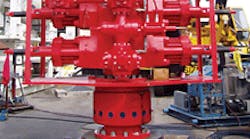Resources: American Petroleum Institute, www.api.org |
Blowout preventers (BOPs) on subsea drilling rigs are the last line of defense against catastrophic oil spills. But as the Deepwater spill shows, they are far from infallible.
They’ve been around since 1920 and their purpose hasn’t changed much over the last 90 years. They are supposed to prevent blowouts from overpressures and subsequent leaks of oil, water, and methane pushing up from below the seabed. They also protect against spills caused by inadvertent breaks in the drilling pipe due to high sea states rocking and rolling the floating rig or rigs that suffer some fatal accident and sink.
What has changed are the conditions BOPs must withstand and still function. Wellhead pressures can now be as high as 25,000 psi, water depths have increased to 10,000 ft, and while temperatures inside the wellbore can reach 400°F, seawater temperatures on the ocean floor can be close to freezing. BOPs must also remain submerged for up to 90 days when drilling a single well or more than a year when several wells are planned for the same general area.
BOP designs have changed, but most changes seemed aimed at lowering costs, not improving safety. For example, advances in metallurgy, hydraulics, and electronics have led to smaller and lighter BOPs. And several BOP makers add two or more differently sized blind shear rams, the critical devices that cut and seal the drilling pipe, so rig operators do not have to change out the rams to accommodate different sized drilling pipe. Other manufacturers, including Varco and Hydril, introduced BOPs that simplify and shorten the task of changing out and inspecting shear rams.
Rams are activated using electronics or hydraulics, as well as by acoustic signals sent underwater. This last option is well suited to last-ditch fail-safe operation because no cable or connection between the surface and BOP is needed. But hydraulic systems are powered by accumulators, and they can leak. And electric systems rely on battery packs, which can lose their charge. So in case of dire emergencies, remotely operated vehicles are often sent to the sea floor to close the shear rams.
But shear rams have well-known shortcomings. A glaring one is that if the shuttle valve sending hydraulic fluid to both sides of the shear rams fails, the entire device is worthless. Another deficiency is that the shears cannot cut through the couplings used to connect sections of drilling pipe. So if the ram is positioned around a connector, it won’t work. (Some sources say these connectors make up 10% of the length of drilling pipe.)
One solution is to add another shear ram, and it seems most newer BOPs are equipped with at least two rams. Transocean, the firm that ran the failed Deepwater Horizon rig, says 11 of its 14 rigs in the Gulf carry two rams. But BP says the BOP that failed on Deepwater only had one ram because adding another would make the BOP too heavy and cumbersome to transport from well to well on the rig.
Another problem is that drilling pipe has gotten twice as strong over the last 40 years. Combine that with the higher pressures and lower temperatures on the seabed, and the task of shearing and sealing pipes becomes more difficult.
All these problems, and more, are known to oil companies. For example, in a study by the Norwegian firm Det Norske Veritas of deepwater rigs in the North Sea, researchers identified 11 instances in which rig operators activated the BOP. They only worked in six of the wells. Another grim statistic uncovered by a study from West Engineering Services of Texas showed that 7 of 14 BOPs on brand new rigs had never been tested to prove they work in deep water, and just three could cut drilling pipe at their maximum rated depth.
At the same time, oil companies, including BP, sponsored a study that indicated BOPs need only be pressure tested every 35 days, more than doubling the current 14-day test schedule. The study noted that out of 90,000 tests, there were only 62 failures. (The firms argue that the change could save $193 million in lost productivity.)
Risks to both oil companies and the environment, not to mention workers and innocent bystanders, can run in the billions of dollars, as amply illustrated by the Deepwater Horizon fiasco. So it would seem a prudent step for the oil industry and government bodies regulating them to undertake some serious risk analysis, then rewrite and strictly enforce rules on designing, real-world testing, operating, and maintaining BOPs.
